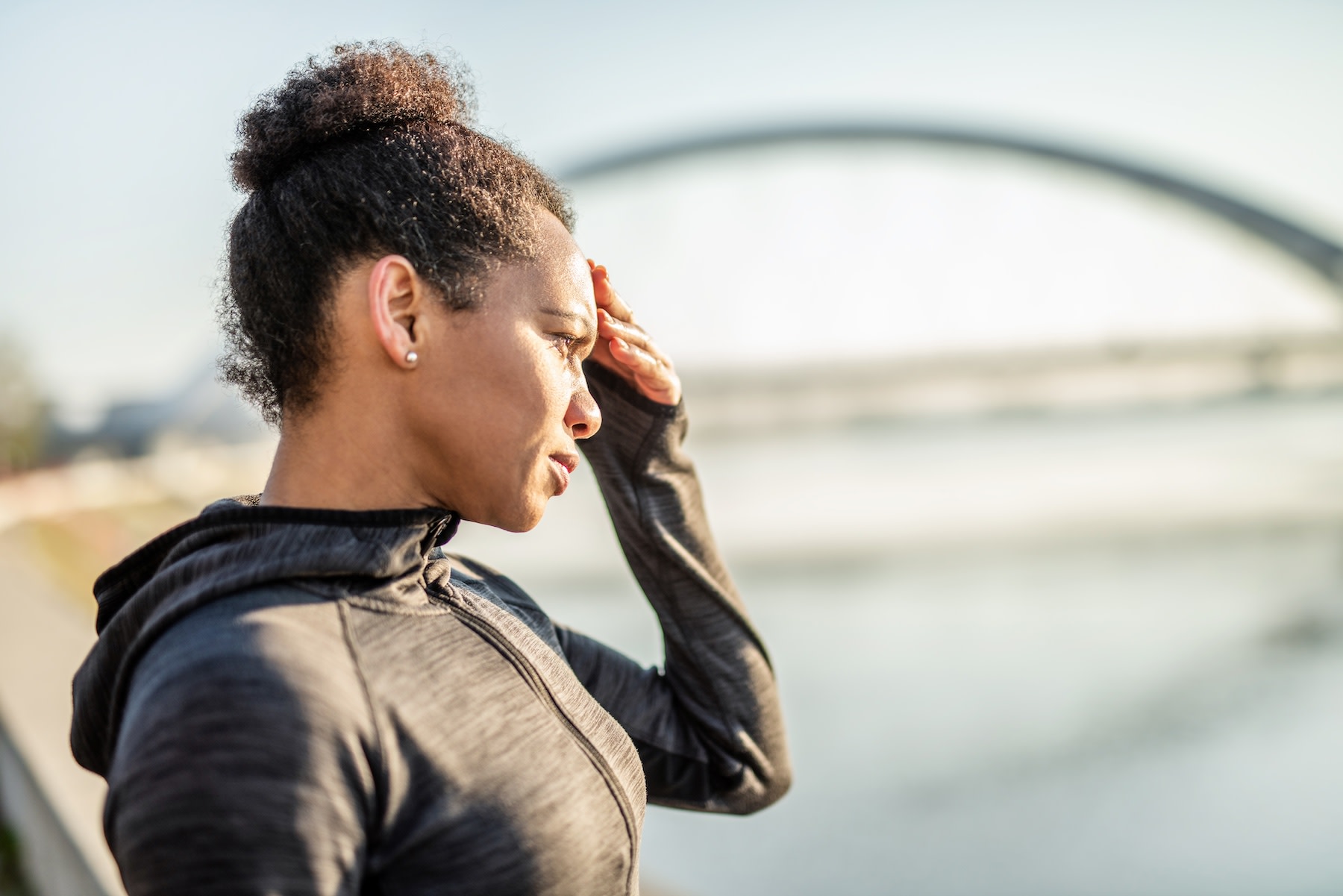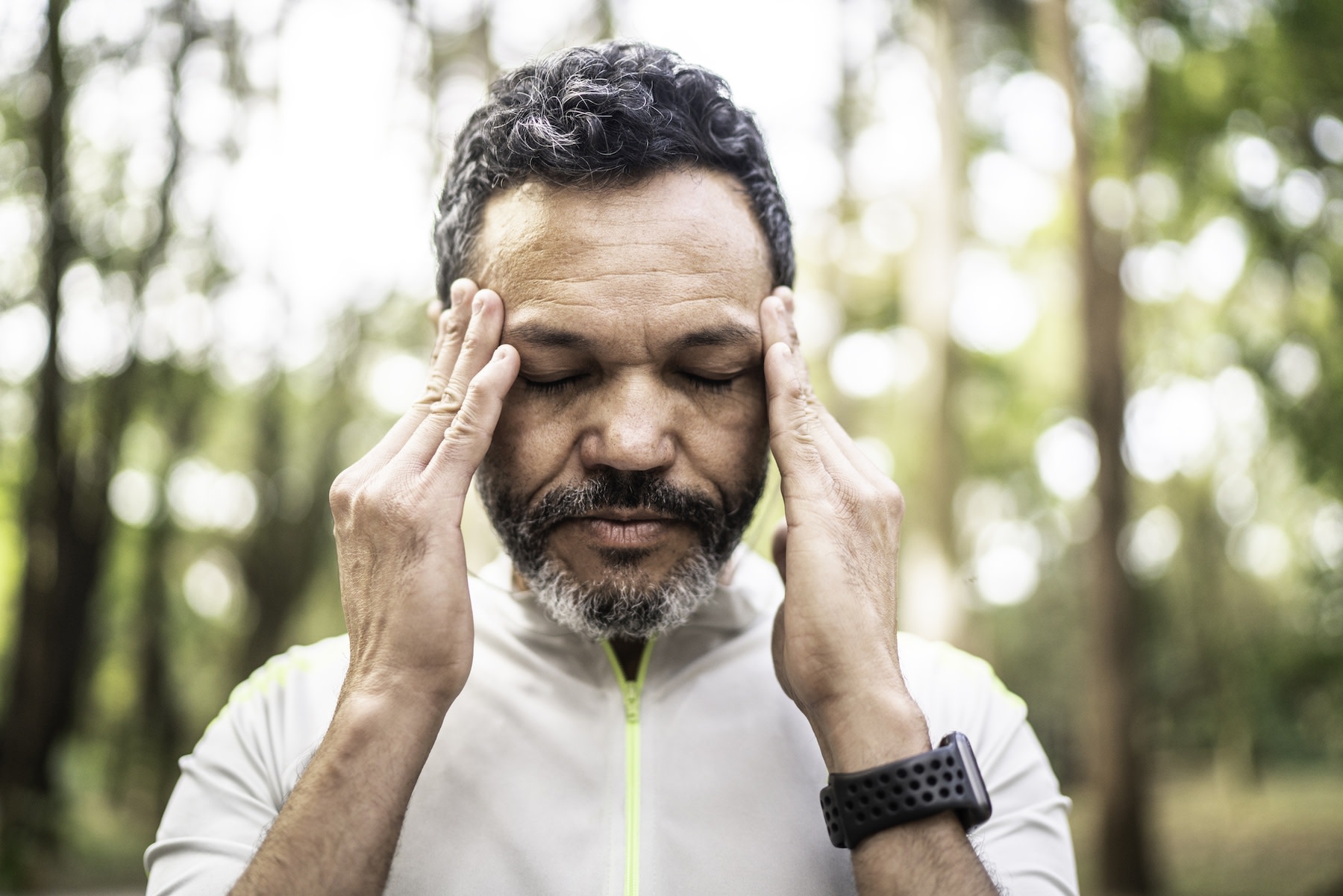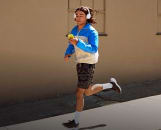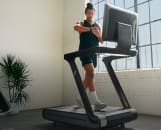
DjelicS / iStock / Getty Images Plus via Getty Images
How to Prevent a Headache After a Workout, According to Doctors
Because the last thing you need after a tough training session is head pain.
By Blake Bakkila, Jennifer Heimlich•
What Are Workout Headaches?
What Do Workout Headaches Feel Like?
Why Do Exertion Headaches Happen?
Are Certain Workouts More Likely to Give You an Exertion Headache?
How to Treat Exercise Headaches
Can You Prevent Headaches After Workouts?
When to Talk to Your Doctor About Exercise Headaches
The Takeaway
After pushing yourself during an intense training session, all you really want to do is enter recovery mode and peacefully relax. But that’s not exactly possible when you get hit with a headache after working out.
This unwelcome head pain could be an exercise or exertion headache, a rare yet incredibly frustrating problem among athletes. There are a few different symptoms that can signal exactly what type of headache you’re experiencing and, fortunately, a variety of preventative measures to fend off an exercise-induced headache.
To understand more, we spoke with three doctors about why headaches after workouts may happen, treatment and prevention tips, and when it’s time to reach out to your healthcare provider.
What Are Workout Headaches?
Workout headaches are just what they sound like: head pain that sets in during or shortly after exercise.
Healthcare providers often group exercise-induced headaches into two different categories: primary and secondary. Primary exercise headaches are typically harmless and involve head symptoms only, while secondary exercise headaches come with other symptoms and could be linked to an underlying, potentially serious problem, according to Mayo Clinic. A primary exercise headache also shouldn’t be confused with an exercise-induced migraine, adds Cara J. Hall, MD, a sports medicine specialist with Keck Medicine of USC.
Because there are other underlying causes associated with secondary exercise headaches, we’ll focus on how to treat and prevent primary exercise headaches in this article. If you think your symptoms fall into the secondary exercise headache category, it’s best to seek out immediate medical attention. According to the Mayo Clinic, the problem could simply be brought on by a sinus infection. But a secondary exercise headache could also be a sign that something more serious is going on like a brain bleed or a vascular issue, says Raj Dasgupta, MD, a quadruple board-certified physician who is the chief medical officer for Garage Gym Reviews. “It’s always better to get checked sooner rather than later,” he says.
What Do Workout Headaches Feel Like?
An exercise-induced headache will affect you differently depending on whether it’s a primary exercise headache, secondary exercise headache, or actually a migraine. There are a few notable differences to look out for.
Key markers of a primary exercise headache include:
Bilateral pain, meaning it affects both sides of the head
Pulsating or throbbing pain
Sets in during or after exercise
Lasts anywhere from five minutes to 48 hours (though the typically lasts about an hour)
By contrast, while a secondary headache also includes pulsing or throbbing pain that sets in during or after exercise, it may also include:
Unilateral pain, meaning it affects one side of the head
Nausea or vomiting
Neck stiffness
Double vision
Sensitivity to light or noise
Loss of consciousness
Lasts one to several days
And an exercise-induced migraine may include:
Pre-migraine symptoms like fatigue, muscle stiffness, food cravings, and nausea, called prodrome
Post-migraine symptoms like fatigue, dizziness, and difficulty concentrating, called postdrome
Sensory, visual, or motor disturbance just before the onset, known as migraine aura
Sensitivity to light or noise

FG Trade / E+ via Getty Images
Why Do Exertion Headaches Happen?
The exact cause of exercise-induced headaches is unknown. But “there are a few different theories, which basically have to do with some sort of cardiovascular dysfunction or dysregulation while exercising,” Dr. Hall says.
One specific theory is that “strenuous exercise dilates blood vessels inside the skull to increase blood flow to the brain in order to meet the increased demand for oxygen,” Dr. Dasgupta says. “That expansion of the blood vessels and subsequent increase in blood pressure creates pressure in the skull, which causes the pain and headache.”
Benjamin Taimoorazy, MD, a headache and pain management specialist at the Beverly Hills Migraine and Pain Management Institute, explains that because our brain sits in the skull, which obviously can’t expand, anytime you change the volume of blood or cerebrospinal fluid around the brain, that can cause a headache.
With that in mind, doctors know that certain risk factors can make you more prone to experiencing a primary exercise headache, including the below.
1. Overexertion
“When you’re exercising intensely, more blood rushes to your brain, which can make the blood vessels there expand and cause pain,” Dr. Dasgupta says. “Another possible reason is the tense muscles in your neck and upper body from tough workouts.”
2. Dehydration
“If you’re not drinking enough water before or during your workout, it can affect your body’s balance of fluids and salts, possibly leading to these headaches,” Dr. Dasgupta says. When we’re dehydrated, our brain tissues actually shrink, pulling away from our skull, which can irritate nearby nerves, according to the Cleveland Clinic.
3. Exercising at a High Altitude
Traveling to a high altitude and not giving your body enough time to adjust could induce a headache after exercise. “In high altitudes, the brain's blood vessels expand in response to reduced oxygen levels,” Dr. Dasgupta explains. “This is the body's natural attempt to deliver more oxygen to brain tissue. However, this vasodilation can also lead to increased pressure and potential swelling, contributing to altitude sickness symptoms like headaches, especially during a workout.” Experts recommend taking at least one rest day (if not a few) to acclimate whenever you ascend 2,500 meters or more.
4. Extreme Weather
Weather conditions, particularly warm climates, may make athletes more prone to getting a headache after a workout. “Working out in really hot or cold conditions stresses the body more,” Dr. Dasgupta explains. “In the heat, you can get dehydrated fast, and in the cold, your blood vessels tighten up. Both situations can set the stage for a headache, especially if you’re pushing yourself hard.”
5. Stress or Anxiety
When we’re struggling with our mental health, we have a lower threshold for any kind of pain—including exercise-induced headaches. “Something that is not painful for an average person becomes painful at a lower threshold in a person with anxiety or depression,” Dr. Taimoorazy says. What’s more, we often tighten up the muscles in our necks and shoulders when we’re stressed or anxious, and our blood pressure rises, Dr. Dasgupta adds. Put that all together, and it’s a recipe for a headache.
In addition to these risk factors, Dr. Dasgupta says that a history of high blood pressure can also bring on headache symptoms.
Are Certain Workouts More Likely to Give You an Exertion Headache?
Exercises that involve overexertion or stress on the body can increase your likelihood of getting a headache after working out. More strenuous activities like running, high-intensity interval training (HIIT), and heavy weight lifting can trigger these headaches because of increased blood pressure.
These activities may also prompt a headache after exercise because you may be performing the Valsalva maneuver during your workout, according to Dr. Dasgupta. “This maneuver is a technique that involves exhaling against a closed airway, which can cause an increase in blood pressure,” he says. During a workout, you might trigger the Valsalva maneuver by engaging in activities that require you to exhale against resistance, such as lifting heavy weights or doing sit-ups, he explains. Engaging in this “bearing-down sensation,” as Dr. Hall describes it, might provoke an unwelcome headache after exercise.
How to Treat Exercise Headaches
One person’s exercise headache may be different than their gym buddy’s, especially because the timeframe for a primary exercise headache is such a wide range. (Remember, it can last anywhere from five minutes to 48 hours.) While Dr. Hall says it’s best to try to prevent exercise-induced headaches from happening in the first place, there are some ways to treat them when they strike:
Decreasing the intensity of your workout or stopping your workout early
Trying an over-the-counter pain reliever, such as acetaminophen, ibuprofen, or naproxen (so long as it’s recommended by your doctor)
If your headache lasts longer than 48 hours, you can generally rule out a primary exercise headache. Whichever type of headache you think you might have, it’s always best to speak with your doctor about the best treatment options for you.
Can You Prevent Headaches After Workouts?
Dr. Hall says that preventing future headaches is not only possible, but it’s also your best course of action, as mentioned above. That’s because it’s significantly more difficult to treat an exercise headache once it sets in. “When you’re doing it after the fact, especially with hydration, it’s just a little less successful,” Dr. Hall explains.
Here are some tried-and-true preventative measures to ward off a potential exertion headache, according to our experts:
Warm up before exercising. A proper warm-up before your workout can help you avoid exercise headaches. “If you start engaging in that exertion gradually, then your brain and your body and your circulation has time to adapt,” Dr. Taimoorazy says. That way you won’t get that sudden rush of blood to your brain, he explains.
Drink more water, ideally with electrolytes. “Making sure you’re hydrated before you exercise makes sure your fluids are balanced,” Dr. Hall says.
Choose a temperate workout environment. Because hot or cold weather may cause headache-inducing changes in blood flow, try to find an indoor workout environment or more temperature-regulated area to perform your exercise routine if possible when outdoor temps are extreme.
Maintain good posture. Poor posture is also attributed to causing a workout-induced headache, according to Dr. Dasgupta. This is likely because it can lead to tense muscles in your neck or upper body that can trigger head pain.
Don’t push yourself too hard. While you might want to put everything you have into your workout, avoid overexertion. Dialing it back and decreasing your intensity can potentially prevent a headache after exercise.
Prepare for training at high altitudes. “If you are going to do a workout in high altitude, I would take a while to acclimate before doing the workout,” Dr. Hall says. “For a few days, just do your everyday activities and not something super intense for your first workout. Build up to it.” This will give your body time to adjust to the atmospheric pressure at high elevations.
Get enough high-quality sleep. “This is more for migraines, but for people who are headache-prone, sleep is super important,” Dr. Hall says. Dr. Dasgupta also adds that “getting good quantity and quality sleep” is essential.
Your healthcare provider may also recommend an over-the-counter or prescription anti-inflammatory that you can take before exercising—but as always, talk to your doctor to see what’s best for you.
Related Articles
When to Talk to Your Doctor About Exercise Headaches
Headaches after exercise should be discussed with your doctor—especially if they are persistent, severe, sudden, or associated with fainting or feeling confused. “Though primary exercise-induced headaches are often harmless, it's crucial to take them seriously and address any underlying issues, especially if they are sudden or persistent,” Dr. Dasgupta says. “If the headache feels different from anything you've had before or lingering longer than it should, that’s a red flag.”
Dr. Hall adds that primary exercise headaches can also be associated with cardiac risk factors, so it’s also important to verify that your blood pressure and cholesterol are both under control. It’s smart to also seek out a neurologist who has advanced training in headache medicine.
“It’s a diagnosis of exclusion,” Dr. Hall says. “A lot of the time, we end up ordering head imaging to prove it’s the primary exercise-induced headache. That might be as simple as a brain MRI or a CT of the head, and just running different labs to check out someone’s cardiovascular risk factors.”
In the best case scenario, they’ll find that nothing else is at play—and will be able to solve the problem. “The good news is prescription medication is effective almost 100 percent of the time,” Dr. Taimoorazy says.
The Takeaway
A headache after a workout can be extremely frustrating, but if you’re struggling from a primary exercise headache—which usually comes with throbbing pain, is felt on both sides of the head, and lasts up to 48 hours—know that it’s usually harmless. While the exact cause of exercise headaches is unknown, you may be more likely to experience a post-workout headache due to overexertion, dehydration, or exercising in high altitude or extreme weather. Prevention methods like drinking enough water, warming up before a workout, and not pushing yourself too hard are key to warding off a headache after exercise.
All that said, if you’re working out and experience a headache afterward, it’s not something to ignore. Even if you think it qualifies as a primary exercise headache, you’ll want to check in with a healthcare professional—ideally a neurologist—who can give you a proper diagnosis and recommend treatment and preventative care. Personalized advice from a doctor is always encouraged, and it may allow you to address other potential concerns involving your blood pressure or cholesterol, among other things. In extreme situations, it could also lead to a secondary exercise headache diagnosis, which could be the first step you need to get life-saving treatment.

Peloton App
Access thousands of classes with no equipment needed.
This content is for informational and educational purposes only and does not constitute individualized advice. It is not intended to replace professional medical evaluation, diagnosis, or treatment. Seek the advice of your physician for questions you may have regarding your health or a medical condition. If you are having a medical emergency, call your physician or 911 immediately.
Level up your inbox.
Subscribe for a weekly dose of fitness, plus the latest promos, launches, and events.
By providing your email address, you agree to receive marketing communications from Peloton.
For more about how we use your information, see our Privacy Policy.






